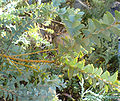Acacia cultriformis: Difference between revisions
No edit summary |
No edit summary |
||
| (One intermediate revision by one other user not shown) | |||
| Line 3: | Line 3: | ||
|genus=Acacia | |genus=Acacia | ||
|species=cultriformis | |species=cultriformis | ||
|common_name=Dogtooth Wattle, Half-moon | |common_name=Dogtooth Wattle, Half-moon W., Golden-glow W., Knife-leaf w., Ploughshare w. | ||
|habit=shrub | |habit=shrub | ||
|habit_ref=Flora - A Gardener's Encyclopedia | |||
|Min ht box=6 | |Min ht box=6 | ||
|Min ht metric=ft | |Min ht metric=ft | ||
| Line 17: | Line 18: | ||
|origin=Australia | |origin=Australia | ||
|lifespan=perennial | |lifespan=perennial | ||
|life_ref=Flora - A Gardener's Encyclopedia | |||
|exposure=sun | |||
|sun_ref=Flora - A Gardener's Encyclopedia | |||
|features=flowers | |features=flowers | ||
|flower_season=early spring, mid spring, late spring | |flower_season=early spring, mid spring, late spring | ||
|flower_ref=American Hort Society | |flower_ref=American Hort Society | ||
|flowers=yellow | |flowers=orange, yellow | ||
|Temp Metric=°F | |Temp Metric=°F | ||
|min_zone=9 | |min_zone=9 | ||
| Line 28: | Line 32: | ||
|image_width=240 | |image_width=240 | ||
}} | }} | ||
The '''Knife-leaf Wattle''' (''Acacia cultriformis''), also known as the '''Dogtooth Wattle''', '''Half-moon Wattle''' or '''Golden-glow Wattle''', is a perennial tree or shrub of the [[genus]] ''[[Acacia]]'' native to [[Australia]]. It is widely cultivated, and has been found to have naturalised in [[Asia]], [[Africa]], [[North America]], [[New Zealand]] and [[South America]].<ref name="ildis"/> ''Acacia cultriformis'' grows to a height of about 2- | The '''Knife-leaf Wattle''' (''Acacia cultriformis''), also known as the '''Dogtooth Wattle''', '''Half-moon Wattle''' or '''Golden-glow Wattle''', is a perennial tree or shrub of the [[genus]] ''[[Acacia]]'' native to [[Australia]]. It is widely cultivated, and has been found to have naturalised in [[Asia]], [[Africa]], [[North America]], [[New Zealand]] and [[South America]].<ref name="ildis"/> ''Acacia cultriformis'' grows to a height of about 2-3 m.<ref>[http://asgap.org.au/a-cul.html Association of Societies for Growing Australian Plants (ASGAP)]</ref> | ||
{{Inc| | {{Inc| | ||
Latest revision as of 15:40, 6 July 2010
| Acacia cultriformis subsp. var. | Dogtooth Wattle, Half-moon W., Golden-glow W., Knife-leaf w., Ploughshare w. | |||||||||||||||||||||||||||||||||||||||||||||||||||||||
|---|---|---|---|---|---|---|---|---|---|---|---|---|---|---|---|---|---|---|---|---|---|---|---|---|---|---|---|---|---|---|---|---|---|---|---|---|---|---|---|---|---|---|---|---|---|---|---|---|---|---|---|---|---|---|---|---|

|
|
| ||||||||||||||||||||||||||||||||||||||||||||||||||||||
| ||||||||||||||||||||||||||||||||||||||||||||||||||||||||
The Knife-leaf Wattle (Acacia cultriformis), also known as the Dogtooth Wattle, Half-moon Wattle or Golden-glow Wattle, is a perennial tree or shrub of the genus Acacia native to Australia. It is widely cultivated, and has been found to have naturalised in Asia, Africa, North America, New Zealand and South America.[1] Acacia cultriformis grows to a height of about 2-3 m.[2]
| Standard Cyclopedia of Horticulture |
|---|
|
Acacia cultriformis, Cunn. (A. cultrata, Ait.). A tall shrub with gray foliage thickly clothing the branches: phyll. with nerve-like margins, obliquely ovate to almost triangular, 1/2-l in. long, 1/4-1/2in. wide, with gland on upper edge one-third distance from base, the intervening edge straight and closely hugging the branchlets; vein excentric, much curved, ending in mucronate point: racemes axillary, much exceeding the phyll.; fls. 30-40 in a head; sepals half as long as petals; peduncles 1/4in. long: pod a rich brown, with nerve-like margins, 1 1/2-3 in. long, 1/4in. wide, occasionally constricted between the seed; seed oblong, longitudinal; funicle half as long as seed, silvery and enlarged into a cup-shaped aril almost from the beginning; ripe Sept., Oct. Fls. March, Apr. R.H. 1896, p. 503. J.H. III.34:131.—If kept well pruned it makes a good hedge. Has been cult. in Calif, for many years in the open, and is considered a desirable plant. CH
|
Cultivation
- Do you have cultivation info on this plant? Edit this section!
Propagation
- Do you have propagation info on this plant? Edit this section!
Pests and diseases
- Do you have pest and disease info on this plant? Edit this section!
Species
Gallery
If you have a photo of this plant, please upload it! Plus, there may be other photos available for you to add.
-
photo 1
References
- Standard Cyclopedia of Horticulture, by L. H. Bailey, MacMillan Co., 1963
External links
- w:Acacia cultriformis. Some of the material on this page may be from Wikipedia, under the Creative Commons license.
- Acacia cultriformis QR Code (Size 50, 100, 200, 500)
- ↑ Cite error: Invalid
<ref>tag; no text was provided for refs namedildis - ↑ Association of Societies for Growing Australian Plants (ASGAP)




